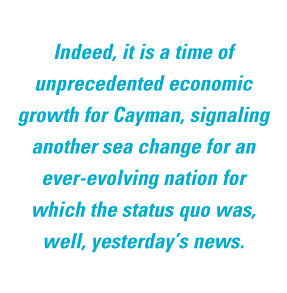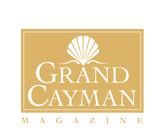Grand Cayman is getting even grander.
It’s written all over these pages – a new wave of upscale resorts and residences, tremendous growth in stayover tourism, and impressive (and imperative) upgrades to our roadways and airport.
Indeed, it is a time of unprecedented economic growth for Cayman, signaling another sea change for an ever-evolving nation for which the status quo was, well, yesterday’s news.
It is remarkable how far the island has come since those the financial and tourism industries first emerged in the mid-1960s, a modern history still recent enough that many of our now-seniors witnessed its conception and contributed to its progress.
A reminder of those early days are the ongoing celebrations marking the 60th anniversary of the creation of the Cayman Islands coat of arms – the first symbol of national identity. This historic emblem, introduced in 1958, marked a significant shift in the territory’s future. It was a step towards Cayman’s independence from Jamaica – a “divorce” which was both consequential and fortuitous, leading to economic prosperity that otherwise may well have eluded us.
Grand Cayman Magazine is recognizing the Diamond Jubilee of the coat of arms by including a special section in this issue (See Page 97) highlighting the notable inroads Cayman has made since that time as well as highlighting its blossoming future. Public and private enterprises (including our own publishing house) share their stories – and they are a fascinating look at many humble beginnings and success stories.
Readers will also travel down memory lane with “Wish You Were Here: A Cayman postcards retrospective” (Page 82). Pinnacle’s own Ivan Burges has published a small book (two, actually; the original and a sequel) entitled “Grand Cayman On Old Postcards,” which offer a remarkable glimpse into the island’s past, people, and its ever-changing urbanscape.
 Another story (Page 70) steeped in history highlights the legends and lore of heraldic university shields discovered in the old library building downtown.
Another story (Page 70) steeped in history highlights the legends and lore of heraldic university shields discovered in the old library building downtown.
Friends of the Library member Michael Pilling is compiling a guide about the history behind each shield and reveals that many shields have fascinating antecedents and alumni. Cambridge, for example, counts Isaac Newton, Charles Darwin, Stephen Hawking, John Milton, Lord Tennyson and, more recently, Ian McKellen, Emma Thompson, Tom Hiddleston and most of the cast of Monty Python’s Flying Circus among its former students.
As the government stages Celebrate Cayman commemorative events both at home and abroad, we invite readers to explore a story that is closer to our heart, indeed to all hearts – simple human kindness.
The story (Page 64) features a charity that is based on this very precept – Acts of Random Kindness (ARK). The group touches the lives of many with its generous actions, helping to build a better community.
In the financial services realm, we shatter several myths and misconceptions when it comes to money laundering, tax fraud and transparency.
British playwright and novelist Somerset Maugham once dubbed the French Riviera as “a sunny place for shady people.” Many argue novelist John Grisham created the same impression of the Cayman Islands with his legal thriller “The Firm.” The best-seller was turned into a blockbuster movie shot partially in Cayman starring Tom Cruise and Gene Hackman. It tells the tale of a tax law firm that devises front companies for the Mafia to commit money laundering and tax fraud in the Cayman Islands.
We’ve talked with John Grisham about his book and his setting much of it in Grand Cayman. First, the book was fiction, not fact, and second, and perhaps of interest, Grand Cayman as a venue for Grisham’s plot was more coincidental than purposeful. Grisham had visited Cayman a few years earlier as a tourist before he wrote this book. For his plot he needed a Caribbean destination that wouldn’t require an inordinate amount of additional research or travel. In other words, it coulda been Barbados or Turks; turned out it was Cayman.
In any event, read the story (Page 88) about the legitimate protection of wealth – and financial privacy. Both, in our view, are worth preserving – and defending.


















